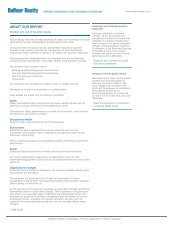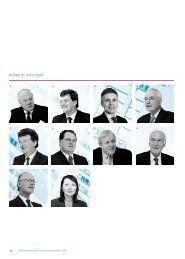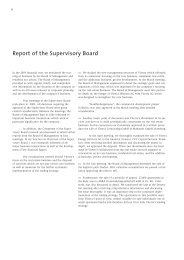E_mg_GB_03_vorne-29_3_04
E_mg_GB_03_vorne-29_3_04
E_mg_GB_03_vorne-29_3_04
You also want an ePaper? Increase the reach of your titles
YUMPU automatically turns print PDFs into web optimized ePapers that Google loves.
142<br />
Since fiscal 2001/2002, a uniform corporation tax rate of 25% and the so-called half-income system<br />
of taxation have applied to German limited companies. Under Germany’s flood victims’ solidarity<br />
legislation of September 19, 2002, the rate of German corporation tax for fiscal 20<strong>03</strong> was raised on a<br />
one-off basis by 1.5 percentage points to 26.5%.<br />
At December 31, 2002, German companies therefore calculated deferred taxes for fiscal 20<strong>03</strong> based<br />
on the corporation tax rate of 26.5% (28% including the solidarity surcharge) applicable for this year.<br />
German companies’ computation of deferred taxes was thus based on the pertinent tax rates of<br />
26.4% and 28.0% and the relevant trade tax rates of 13.3% and 13.0% respectively. The calculation<br />
of German companies’ deferred taxes was therefore based on a total rate of 39.7% and 41.0% respectively.<br />
The impact of this tax increase due to the flood victims’ solidarity legislation, which was<br />
limited to one year, was not of material importance. At December 31, 20<strong>03</strong>, German companies are<br />
calculating their deferred taxes based on an overall tax rate of 39.7%.<br />
Deferred taxes are computed using national tax rates which, according to the enacted law in the<br />
respective countries at the balance sheet date, will apply on the date on which the timing differences<br />
are likely to be eliminated or net operating loss (NOL) carryforwards are likely to be utilized.<br />
The following breakdown of tax expense for fiscal 20<strong>03</strong> is based on an overall tax rate of 39.7% and<br />
reconciliation to the effective tax rate of 30.6%:<br />
1/1/20<strong>03</strong> - 10/1/2002 -<br />
12/31/20<strong>03</strong> 12/31/2002<br />
u ’000 t ’000<br />
Expected income tax benefit (prior year: income tax expense) – 71,870 10,391<br />
Non-deductible expenses<br />
Foreign tax rate differential (including change in<br />
12,068 1,365<br />
valuation allowance on deferred tax assets) – 12,910 3,350<br />
Effect of deferred taxes from affiliated and related companies 13,087 9,128<br />
Change in valuation allowance on deferred tax assets – Germany 12,960 45,117<br />
Other – 8,726 – 11,318<br />
Actual income tax benefit (prior year: income tax expense) – 55,391 58,<strong>03</strong>3<br />
Deferred tax assets and liabilities are recognized for all temporary differences between the amounts<br />
reported in the tax accounts and those in the U.S. GAAP financial statements included in the consolidated<br />
accounts. Deferred taxes are also recognized in relation to various consolidation measures.<br />
Furthermore, deferred tax assets are recognized for losses carried forward. If deferred tax assets are<br />
unlikely to be realized, a valuation allowance is reported. Deferred tax liabilities on retained earnings<br />
at foreign subsidiaries of <strong>mg</strong> technologies ag were not established, because the vast majority of these<br />
earnings are not intended to be distributed in the future either, but constitute a permanent investment.<br />
The calculation of the deferred taxes not reported would have involved a disproportionate amount of<br />
time and effort. The primary components of deferred tax assets and liabilities and the related valuation<br />
allowances result from adjustments in the following items:









